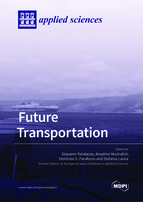Future Transportation
A special issue of Applied Sciences (ISSN 2076-3417). This special issue belongs to the section "Transportation and Future Mobility".
Deadline for manuscript submissions: closed (20 September 2023) | Viewed by 85265
Special Issue Editors
Interests: geography; geomorphology; geology
Special Issues, Collections and Topics in MDPI journals
Interests: remote sensing; unmanned aerial vehicles (UAVs); image processing; farming by satellite; geographic information system (GIS); applied geophysics; coastal studies; climate change; land use/cover change; anthropogenic impact; landscape planning; engineering geology; ecological studies
Special Issues, Collections and Topics in MDPI journals
Interests: agricultural machinery automation; ISOBUS technologies; unmanned ground and aerial vehicles; decentralized and resilient digital farming systems
Special Issues, Collections and Topics in MDPI journals
Interests: geography; geomorphology; sedimentology
Special Issues, Collections and Topics in MDPI journals
Special Issue Information
Dear Colleagues,
Transportation of people and goods is operated in the air, on the land, on the sea, and recently to the edge of the space. Transportation relies on effective vehicles, good infrastructures, as well as good environmental conditions. Transportation contributes significantly to the ongoing changes in climate and is at the same time affected by the global crises which lead to global supply chain shutdowns. The changing climate is creating new waterways in the Arctic, triggering coastal erosion, and is affecting maritime traffic systems. In time, further exciting advancements are expected to emerge in the field of transportation as the USA and the EU are investing billions of USD and EUR, respectively, on new infrastructures, most of them connected with transportation. The challenge is to give the chance to the territories to start their own economies again and to create new systems of soft mobility for new generations of users. With the continuously evolving technologies, transportation of people and goods is becoming smart and intelligent. New autonomous and electrical vehicles are being produced, and government and private sector actors are producing and installing sensors and platforms aiming at providing crucial information on the state of the air, land, and sea. A number of satellites and unmanned aerial vehicle sensors provide crucial information on the state of maritime, land, and air conditions. On-ground sensors and cameras provide important information on the current state of the abovementioned environments. Future transportation will rely heavily on information provided by these sensors, platforms, and their connectivity to transport vehicles. It will greatly benefit from smooth flow of information between these platforms, sensors, and vehicles enabled by the internet and other kinds of modern communications. However, efficiency and the security of that flow and transfer of information is the most important aspect of future transportation of people and goods.
This Special Issue will focus on the latest advances in technologies aiming at future transportation of people and goods. Authors are invited to submit original manuscripts on topics including (but not limited to):
- Smart cities and smart logistics;
- The environmental effects of transport;
- Green transport;
- Blockchain and the Internet of Things;
- Artificial Intelligence and machine and deep learning for the mining of raw materials;
- Bicycle sharing;
- Photogrammetry for coastal areas, maritime and land monitoring;
- New active and passive sensors for autonomous vehicles;
- Geological mapping of nickel, copper, cobalt, and platinum;
- Climate and energy technologies;
- Evaluation of the impact of transportation on coastal cities and coastal morphological evolution;
- New sensors and their applications for fault movements and seismicity analyses and sediment management;
- Satellite technologies for transportation of people and goods;
- New harbors, new bridges, and tunnel constructions;
- Micromobility;
- Bathymetry mapping of uncharted and hard-to-reach waters for marine transportation and sunk obsolete ships detection.
Prof. Dr. Giovanni Randazzo
Dr. Anselme Muzirafuti
Prof. Dr. Dimitrios S. Paraforos
Dr. Stefania Lanza
Guest Editors
Manuscript Submission Information
Manuscripts should be submitted online at www.mdpi.com by registering and logging in to this website. Once you are registered, click here to go to the submission form. Manuscripts can be submitted until the deadline. All submissions that pass pre-check are peer-reviewed. Accepted papers will be published continuously in the journal (as soon as accepted) and will be listed together on the special issue website. Research articles, review articles as well as short communications are invited. For planned papers, a title and short abstract (about 100 words) can be sent to the Editorial Office for announcement on this website.
Submitted manuscripts should not have been published previously, nor be under consideration for publication elsewhere (except conference proceedings papers). All manuscripts are thoroughly refereed through a single-blind peer-review process. A guide for authors and other relevant information for submission of manuscripts is available on the Instructions for Authors page. Applied Sciences is an international peer-reviewed open access semimonthly journal published by MDPI.
Please visit the Instructions for Authors page before submitting a manuscript. The Article Processing Charge (APC) for publication in this open access journal is 2400 CHF (Swiss Francs). Submitted papers should be well formatted and use good English. Authors may use MDPI's English editing service prior to publication or during author revisions.
Keywords
- Intelligent Transportation Systems
- Sustainable Transportation
- Smart Road
- Vehicle Engineering
- Electric Vehicles
- Traffic and Transportation
- IoT
- smart cities
- satellite technologies
- green transport
- space tourism
- automatic control
- remote sensing
- unmanned aerial vehicles (UAVs)
- image processing
- geographic information system (GIS)
- railways
- TGV
- Electric Vehicles
- Bicycle Sharing
- 5G
- Galileo
- Copernicus Sentinel satellites
- applied geophysics
- climate change
- land use/cover change
- landscape planning
- 2D imaging, 3D imaging
- machine learning
- deep learning
- multispectral data analysis
- hyperspectral data analysis
- LIDAR data analysis
- RADAR data analysis
- coastal environment
- tourism
- aerial photogrammetry
- automation and robotics
- wireless sensor networks
- Autonomous vehicles
- traffic monitoring
- drones
- GPS
- port shutdown
- containers and shipping rates
- coastal geomorphologist
- bathymetry mapping
- point cloud acquisition and analysis
- environmental impact









